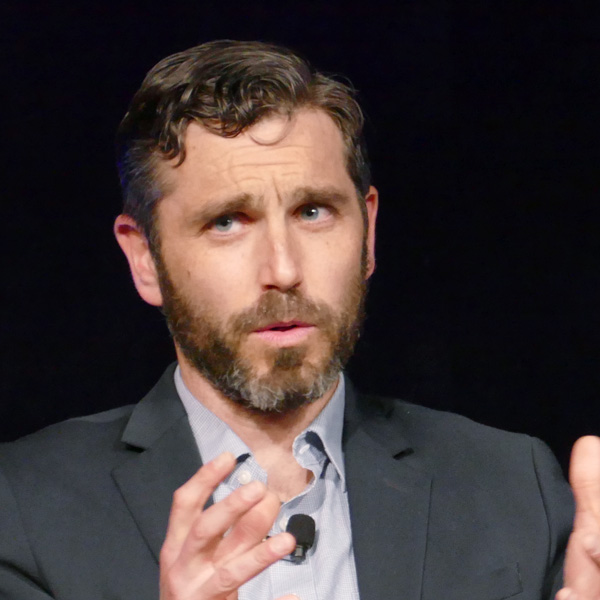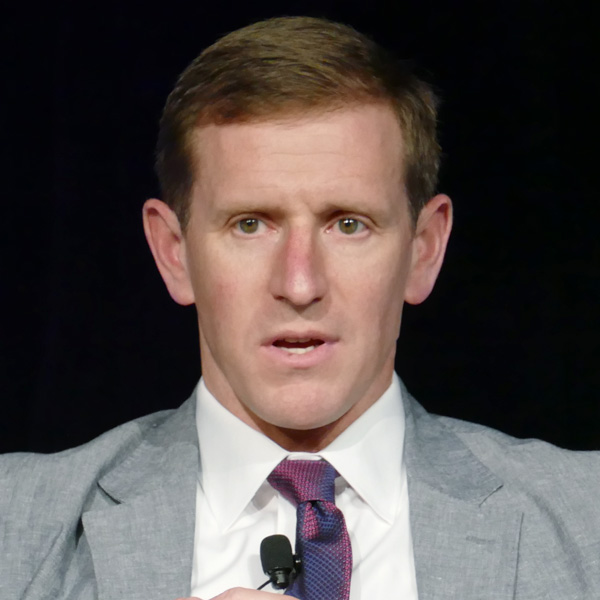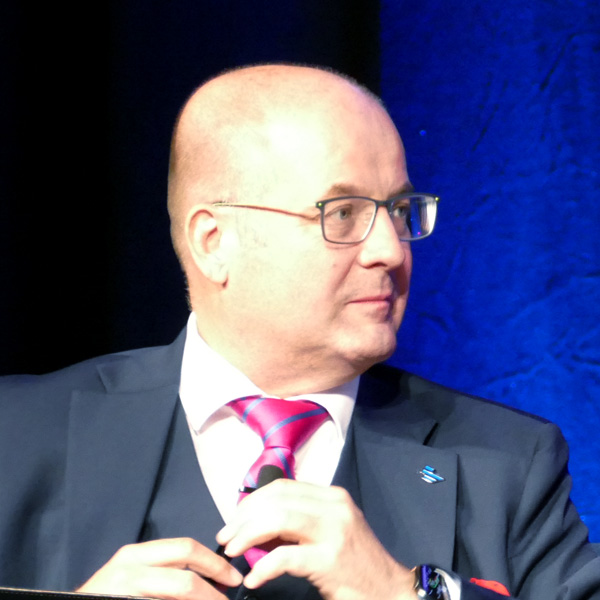
SACRAMENTO, Calif. — West Coast states need to work together on transmission, ports and industrial infrastructure to achieve their goals for floating offshore wind, speakers at this year’s Pacific Offshore Wind Summit said.
The two-day event, hosted by Offshore Wind California, drew 700 attendees to the SAFE Credit Union Convention Center in downtown Sacramento on May 9-10.
Panelists encouraging collaboration cited lessons learned, both positive and negative, from the East Coast’s experience developing offshore wind projects and infrastructure.
 Travis Douville, Pacific Northwest National Laboratory | © RTO Insider LLC
Travis Douville, Pacific Northwest National Laboratory | © RTO Insider LLC“What we have learned is that there’s great power in bringing the states together,” said Travis Douville, who leads wind energy grid integration research at the Pacific Northwest National Laboratory.
“There already are models of substance in play,” Douville said during a panel on offshore wind transmission. For example, the New England States Transmission Initiative “is showing real promise, and the idea here is that states can come together and develop a shared transmission plan that serves all of their needs at the state level.”
Last year, five New England states — Connecticut, Massachusetts, Maine, New Hampshire and Rhode Island — announced their joint initiative to explore investment in the transmission infrastructure they need to integrate offshore wind and other clean energy resources while improving grid reliability.
In January, the states said in a joint statement that they were seeking funding from the Department of Energy to strengthen New England’s grid and reduce dependence on fossil fuels. (See New England States Group Up To Push For Federal Transmission Funding.)
One of their proposals, the Joint State Innovation Partnership for Offshore Wind, would “proactively plan, identify and select a portfolio of transmission projects needed to unlock the region’s significant offshore wind potential, improve grid reliability and resiliency, and invest in job growth and quality.”
California, Oregon and Washington could benefit from similar arrangements, Douville said.
‘Pacific Coast Scale’
The West Coast states have nearly 300 GW of potential capacity from floating offshore wind turbines, the National Renewable Energy Laboratory estimated in a study last year. California has 88 GW of potential capacity. Oregon has 150 GW, and Washington has 59, NREL said.
The states, federal government and private industry are planning to develop that capacity, starting south and working north.
The Bureau of Ocean Energy Management (BOEM) held the first West Coast wind auction Dec. 7, when five lease areas off the California coast, with 4.5 GW of total capacity, brought more than $757 million in winning bids. (See First West Coast Offshore Wind Auction Fetches $757M.)
Three of the lease areas are in the Morro Bay Wind Energy Area off the coast of Central California, and two are in the Humboldt Wind Energy Area off the coast of Northern California.
The auction was crucial to achieving the Biden administration’s goal of deploying 15 GW of floating offshore wind in deep waters by 2035, the Interior Department said. The California Energy Commission has proposed offshore wind goals of 25 GW by 2045. (See California Boosts Offshore Wind Goals.)
Off the coast of Oregon, BOEM has identified three call areas with 17 GW of capacity, one of which, the Brookings Call Area, is 60 miles north of California’s Humboldt Wind Energy Area. The proximity quickly prompted discussion of collaboration between the West Coast states.
“The growing Pacific Coast scale of this … sets in motion a whole set of speculation about coordination across the region,” Adam Stern, executive director of Offshore Wind California, told an Energy Bar Association meeting shortly after BOEM announced the Oregon call areas Feb. 24, 2022. (See Energy Bar Weighs OSW in Oregon, California.)
In Washington, BOEM has received two unsolicited bids for floating wind farms but has yet to identify any call areas.
‘Economies of Scale’
 Ryan Calkins, Port of Seattle | © RTO Insider LLC
Ryan Calkins, Port of Seattle | © RTO Insider LLCWashington has moved more slowly on offshore wind, in part because of its vast supply of hydroelectric power, said Ryan Calkins, a Port of Seattle commissioner and part of a panel on West Coast collaboration.
“We have such an abundant source of renewable energy in hydro that I think we didn’t get off the starting blocks very quickly,” Calkins said. “However, I think we’re starting to see some real progress.”
The state has an energy strategy that includes 3 GW of offshore wind by 2045, and “oftentimes you’ll hear our state officials talk about ‘it’s not if, but when’ we will get into offshore wind,” he said.
The state is expecting to learn from California’s experience with offshore wind, including its effects on fisheries, coastal communities and Native American tribes, he said.
“When we join California in a few years with our own plans for offshore wind, I welcome the inputs of California ports and supply chains to help us meet our targets,” Calkins said. “I think it just makes sense for us to have a systemwide approach to this.”
Some types of collaboration between the states are already happening and could serve as models for offshore wind, he said. For instance, West Coast ports employ standardized container shipping equipment that allows ships to offload in multiple ports, from Seattle to Long Beach, after crossing the Pacific from Asia. The setup promotes efficiencies of scale, he said.
“We also have a shared workforce, whether it’s the unions that tie us all together or the brain trust behind what we do, and the various contractors that every port relies on for port design or for engineering services,” Calkins said. “Those same sets of skills are going to be needed for the extension of ports along the West Coast.”
On an international scale, “I think that if we manage to pull off strong collaboration on a coastwide level here, we actually have an opportunity to chase a much bigger prize, which is a larger Pacific Rim system developing offshore wind that includes Korea, Japan, China and elsewhere,” he said.
“But if Washington tries to do it alone, or even if California tries to do it alone, we’re not going to have the kind of efficiencies or economies of scale to be able to participate in bilateral trade with some of those nations, which have even bigger goals than we do in a lot of instances,” he said. “So, I think we’d benefit if we collaborate.”
Competition vs. Collaboration
The East Coast has seen a combination of competition and collaboration that has fostered growth but has also led to inefficient development, panelists said.
Molly Croll, Pacific offshore wind director for the American Clean Power Association, said, “Competition as well as collaboration stimulates progress.”
“Competition has been a big part of progress on the East Coast,” Croll said. “There’s been competition for who can set the highest offshore wind target, who can procure the best projects first … and [who can offer the best] local incentives for supply chain and manufacturing. So, competition is a motivator, but obviously competition without collaboration will lead to inefficiencies, gaps and redundancies, which we don’t want.”
Croll, a California resident, said her home state should take the lead.
“I do not want California to wait for other states to get to where California is,” she said. “But I think there’s still so many areas for potential collaboration, [such as] best-practice sharing and information sharing. That’s a no-brainer. We should be doing that. California is doing a lot of things for the first time that Oregon and Washington will benefit from.”
“Then, moving up towards shared planning, I would love to see that, especially if we can coalesce states around a shared vision of large-scale offshore wind,” Croll said. “Harder to do [are] mutual commitments, shared investments, things like that, but we could get there. And hopefully, working on those first steps provides a platform and habit of collaboration.”
 Tony Appleton, Burns & McDonnell | © RTO Insider LLC
Tony Appleton, Burns & McDonnell | © RTO Insider LLCIn a panel on building a sustainable West Coast wind industry, Tony Appleton, offshore wind director for engineering firm Burns & McDonnell, said the West Coast could learn from the East Coast’s mistakes.
“The lesson learned from the East Coast is that not everybody actually worked together,” Appleton said. “Everybody was kind of doing their own thing in their own little silos and actually not realizing what the bigger picture was.”
Developers focused on their own projects, and states competed for ports, jobs and supply chain opportunities, he said.
“I think what, what the West Coast could do — what California, Oregon, etc. can do — is actually work together, get all of those key stakeholders working together, rather than … against each other. Because if you get them working together, they will come up with solutions that everybody’s happy with.”
Europe spent 20 years learning to work together on offshore wind, Appleton said.
If California takes a collaborative approach from the start, “It goes straight from iPhone 8 to iPhone 15 and not through all the steps in the middle.”
